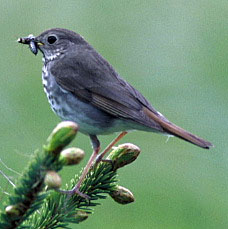
Thrush (bird)
Background to the schools Wikipedia
SOS Children produced this website for schools as well as this video website about Africa. See http://www.soschildren.org/sponsor-a-child to find out about child sponsorship.
| Thrushes | |
|---|---|
 |
|
| Hermit Thrush | |
| Scientific classification | |
| Kingdom: | Animalia |
| Phylum: | Chordata |
| Class: | Aves |
| Order: | Passeriformes |
| Suborder: | Passeri |
| Family: | Turdidae |
| Genera | |
|
Some 20, see text |
|
The Thrushes, family Turdidae, are a group of passerine birds that occur mainly but not exclusively in the Old World.
Characteristics
Thrushes are plump, soft-plumaged, small to medium-sized birds, inhabiting wooded areas, and often feeding on the ground. They range in size from the Forest Rock Thrush (Monticola sharpei), at 21 grams and 14.5 cm (5.8 inches), to the Blue Whistling Thrush (Myophonus caeruleus), at 178 grams (6.3 oz) and 33 cm (13 inches). Most species are grey or brown in colour, often with speckled underparts.
They are insectivorous, but most species also eat worms, snails, and fruit. Many species are permanently resident in warm climes, while other migrate to higher latitudes during summer, often over considerable distances.
Thrushes build cup-shaped nests, sometimes lining them with mud. They lay two to five speckled eggs, sometimes laying two or more clutches per year. Both parents help in raising the young.
The songs of some species, including members of the genera Catharus, Myadestes, and Turdus, are considered to be among the most beautiful in the avian world.
Taxonomy
The taxonomic treatment of this large family has varied significantly in recent years. Traditionally, the Turdidae included the small Old World species, like the Nightingale and European Robin in the subfamily Saxicolini, but most authorities now place this group in the Old World flycatcher family Muscicapidae.
This article follows the Handbook of the Birds of the World with edits from Clement and Hathaway, Thrushes (2000), and retains the large thrushes in Turdidae. Recent biochemical studies place certain traditional thrush genera ( Monticola, Pseudocossyphus, Myiophonus, Brachypteryx, and Alethe) in the Muscicapidae. Conversely the Asian saxicoline genera Grandala and Cochoa belong here among the thrushes.
Genera
FAMILY: TURDIDAE
- Genus Turdus: true thrushes (some 65 species, 1 recently extinct)
- Genus Platycichla (2 species) - part of a South American group within Turdus
- Genus Nesocichla: Tristan Thrush or Starchy - part of a South American group within Turdus
- Genus Cichlherminia: Forest Thrush - genus paraphyletic with Turdus
- Genus Psophocichla : Groundscraper Thrush
- Genus Zoothera: Asian thrushes (some 22 species, 1 recently extinct)
- Genus Catharus: typical American thrushes and nightingale-thrushes (12 species)
- Genus Hylocichla : Wood Thrush
- Genus Ridgwayia: Aztec Thrush - related to Hylocichla
- Genus Ixoreus : Varied Thrush - related to other New World genera
- Genus Geomalia: Geomalia
- Genus Cataponera: Sulawesi Thrush
- Genus Sialia: bluebirds (3 species)
- Genus Grandala, Grandala - related to Sialia
- Genus Cichlopsis: Rufous-brown Solitaire - related to Catharus
- Genus Entomodestes: solitaires (2 species) - related to Catharus
- Genus Myadestes: solitaires (10-11 living species, 2-3 recently extinct)
- Genus Neocossyphus: flycatcher thrushes and "ant-thrushes" (4 species) - related to Myadestes
- Genus Cochoa, cochoas (4 species)
- Genus Chlamydochaera: Fruit-hunter - related to Cochoa
Now usually considered a distinct family distantly related to Picathartes:
- Genus Chaetops: rock-jumpers (2 species)
For other species previously in Turdidae, see Muscicapidae and chats.
